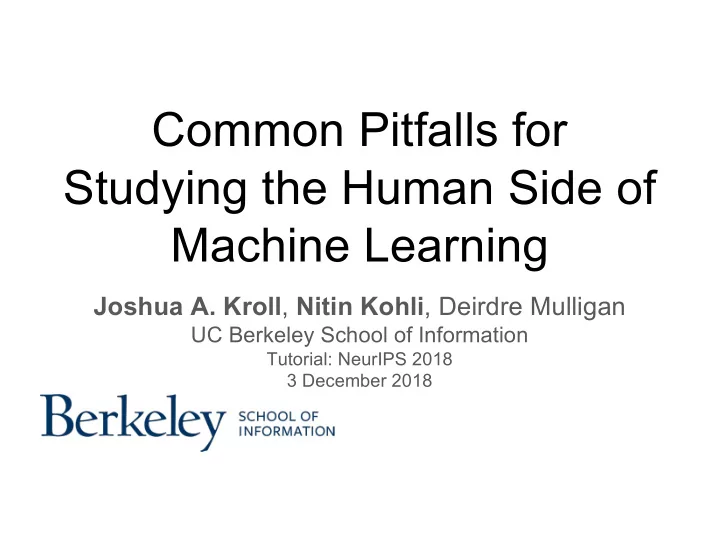

Common Pitfalls for Studying the Human Side of Machine Learning Joshua A. Kroll , Nitin Kohli , Deirdre Mulligan UC Berkeley School of Information Tutorial: NeurIPS 2018 3 December 2018
Credit: Last Year, Solon Barocas and Moritz Hardt, "Fairness in Machine Learning", NeurIPS 2017
Machine Learning Fairness
What goes wrong when engaging other disciplines? ● Want to build technology people can trust and which supports human values ● Demand for: ○ Fairness ○ Accountability ○ Transparency ○ Interpretability ● These are rich concepts, with long histories, studied in many ways ● But these terms get re-used to mean different things! ○ This causes unnecessary misunderstanding and argument. ○ We’ll examine different ideas referenced by the same words, and examine some concrete cases
Why this isn’t ethics Machine learning is a tool that solves specific problems Many concerns about computer systems arise not from people being unethical, but rather from misusing machine learning in a way that clouds the problem at hand Discussions of ethics put the focus on the individual actors, sidestepping social, political, and organizational dynamics and incentives
Definitions are unhelpful (but you still need them)
Values Resist Definition
Definitions aren’t for everyone: Where you sit is where you stand
If we’re trying to capture human values, perhaps mathematical correctness isn’t enough
These problems are sociotechnical problems
Fairness “What is the problem to which fair machine learning is the solution?” - Solon Barocas
What is Fairness: Rules are not processes
Tradeoffs are inevitable
Maybe the Problem is Elsewhere
What is Accountability: Understanding the Unit of Analysis
What should be true of a system, and where should we intervene on that system to guarantee this?
Transparency & Explainability are Incomplete Solutions
Transparency
Explainability
Explanations from Miller (2017) ● Causal ● Contrastive ● Selective ● Social ● Both a product and a process Miller, Tim. "Explanation in artificial intelligence: Insights from the social sciences." arXiv preprint arXiv:1706.07269 (2017).
Data are not the truth
If length is hard to measure, what about unobservable constructs like risk?
Construct Validity
Abstraction is a fiction
There is no substitute for solving the problem
You must first understand the problem
Case One : Babysitter Risk Rating
Xcorp launches a new service that uses social media data to predict whether a babysitter candidate is likely to abuse drugs or exhibit other undesirable tendencies (e.g. aggressiveness, disrespectfulness, etc.) Using computational techniques, Xcorp will produce a score to rate the riskiness of the candidates. Candidates must opt in to being scored when asked by a potential employer. This product produces a rating of the quality of the babysitter candidate from 1-5 and displays this to the hiring parent.
With a partner, examine the validity of this approach. Why might this tool concern people, and who might be concerned by it?
What would it mean for this system to be fair?
What would we need to make this system sufficiently transparent?
Are concerns with this system solved by explaining outputs?
Possible solutions?
This is not hypothetical. Read more here: https://www.washingtonpost.com/technology/2018/11/16/wante d-perfect-babysitter-must-pass-ai-scan-respect-attitude/
(Break)
Case Two: Law Enforcement Face Recognition
The police department in Yville wants to be able to identify criminal suspects in crime scene video to know if the suspect is known to detectives or has been arrested before. Zcorp offers a cloud face recognition API, and the police build a system using this API which queries probe frames from crime scene video against the Yville Police mugshot database.
What does the fact that this is a government application change about the requirements?
What fairness equities are at stake in such a system?
What is the role of transparency here?
Who has responsibility in or for this system? What about for errors/mistakes?
What form would explanations take in this system?
This is not hypothetical, either. Read more here: https://www.aclu.org/blog/privacy-technology/surveillance- technologies/amazons-face-recognition-falsely-matched-28
To solve problems with machine learning, you must understand them
Respect that others may define the problem differently
If we allow that our systems include people and society, it’s clear that we have to help negotiate values, not simply define them.
There is no substitute for thinking
Questions?
Recommend
More recommend